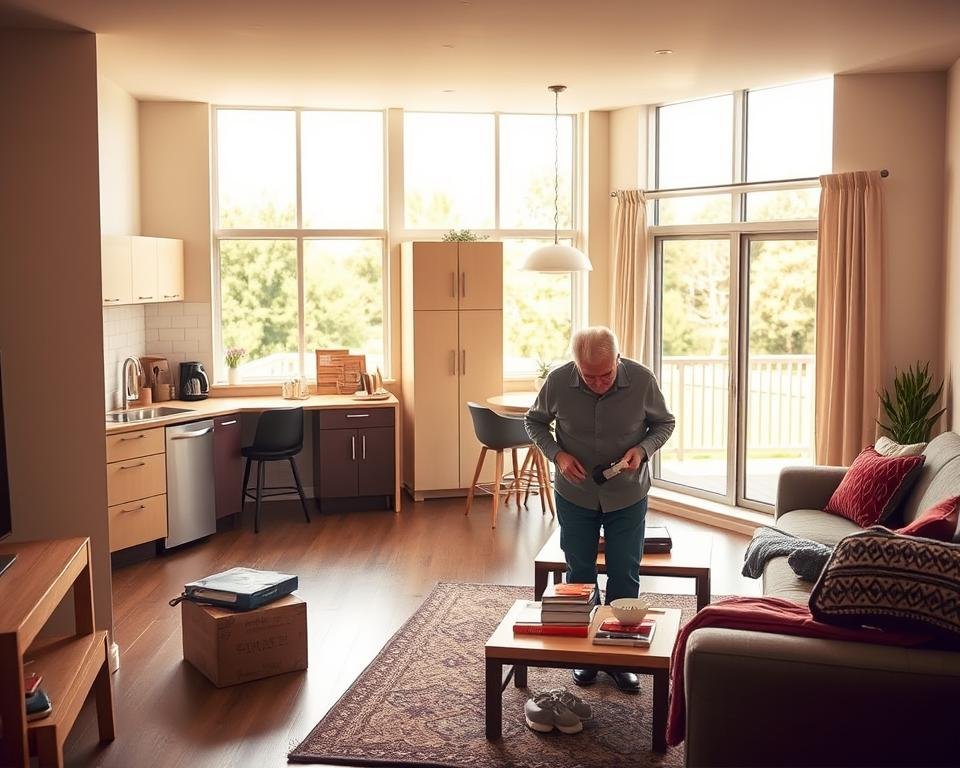In the later stages of life, you might think about downsizing your home. This decision can simplify your lifestyle and bring financial benefits. Many seniors choose smaller homes as they enter retirement. Downsizing is not only practical but also an emotional journey filled with memories.
In our guide, you’ll find essential tips for seniors on making this major change confidently. We’ll discuss the emotional effects and give practical strategies for older adults. Our goal is to keep you informed at every stage.
Key Takeaways
- Downsizing can simplify your lifestyle and reduce living costs.
- Understand the emotional aspects of leaving a long-loved home.
- Set clear goals to make the downsizing process easier.
- Involving family can provide support during this transition.
- Explore different housing options that suit your needs.
- Tips for packing can ensure a smooth move to your new home.
Understanding the Benefits of Downsizing
Opting to downsize can be a pivotal choice, especially for older adults aiming for better living conditions. It offers key benefits addressing their physical and emotional well-being. By choosing a simpler lifestyle, seniors can relish life without the stress of upkeep. Downsizing enables aging adults to live more enjoyably and with less worry.
Simplifying Your Living Situation
Moving to a smaller home means less space to care for. This reduces the physical work of home management. Downsizing ideas for seniors focus on making space more manageable. A tidy space not only boosts safety but also calms the mind, enhancing life quality.
Financial Opportunities and Savings
Downsizing has notable economic advantages. It can cut down on expenses, reducing mortgage payments and property taxes. This shift can free up money for health or recreational uses. For further insights into downsizing’s financial benefits, explore these helpful resources.
Emotional Relief and Stress Reduction
For many retirees, downsizing brings emotional comfort and less stress. A simpler home setting greatly affects mental health. Letting go of unnecessary items offers a freeing sense of achievement. Thus, downsizing becomes a chance for renewal, focusing on meaningful relationships and experiences.

Preparing for Your Downsizing Journey
Starting your downsizing journey requires careful planning and determination. Knowing your goals makes the transition smoother. It gives you clarity and purpose. Seek downsizing help for senior citizens. They offer essential frameworks for making decisions. Begin by identifying your reasons for moving. Are you looking to cut costs, ease maintenance, or relocate closer to family? Recognizing these motivations is crucial to planning.
Setting Clear Goals for Your Move
Setting specific goals refines your downsizing approach. Ask yourself what you hope to achieve and how it fits with your lifestyle. Visualizing the desired outcome provides focus in an emotional process. If needed, seek downsizing guidance for elderly people to effectively navigate decisions.
Assessing Your Current Living Space
Evaluate your current home to decide what’s essential and what’s excess. Measure rooms in potential new homes to see what fits. Consider enlisting family or friends for objective assessments. They can offer insights on what matters most.
Creating a Timeline for the Process
Effective downsizing requires scheduling. Start planning your move at least three months ahead. Break tasks into steps—like sorting possessions, fixing a moving date, and hiring movers. Organization reduces stress by providing a clear roadmap. For further logistics insights, explore resources like this guide on moving. It offers useful strategies and timelines.

Sorting Through Your Belongings
Embarking on the journey of downsizing is both challenging and rewarding. The key step in this process is sorting through your belongings. By making deliberate choices about what to keep, sell, or donate, you craft a living space that mirrors your current desires and needs. Using downsizing resources for older individuals can simplify this transition.
Deciding What to Keep, Sell, or Donate
Start by categorizing your items based on their value and sentiment. Consider if each item is purposeful or brings joy. Keeping only meaningful possessions can greatly diminish clutter. Acquainting yourself with downsizing strategies for elderly helps minimize emotional distress. Items that no longer serve your lifestyle can be sold, donated, or thrown away. This allows you to enjoy a simpler environment.
Organizing Your Items Effectively
Post-categorization, organization is key. Tackle the process room by room, utilizing labeled containers for item tracking. This method facilitates packing and eases the transition to your new space. Practical downsizing resources for older individuals ensure systematic coverage, paving the way for clear decisions.
Involving Family in the Process
Involving family in your downsizing journey can be beneficial. Have conversations about what items to keep, share, or relinquish. This cooperation can uncover valuable moments, with family members valuing items you’re ready to release. Open communication not only offers support but turns the process into a chance for reminiscing and building memories.
Finding the Right New Home
Choosing a new home is a vital step in your downsizing process. You should consider various housing options that fit your evolving lifestyle needs. This includes looking into smaller homes, townhouses, condos, and retirement communities. Each choice offers benefits like lower maintenance and better accessibility, important for older adults.
Exploring Different Housing Options
Think about what living situation aligns with your preferences and future necessities. Exploring retirement communities could provide social connections, whereas smaller homes might offer customization. Accessory dwelling units are also an option, offering the independence of a private space with the convenience of being close to assistance if needed.
Important Features to Consider
In your home search, focus on important features like layout, accessibility, and community amenities. Choose a place that supports your lifestyle now and in the future. Look for elements that will make your day-to-day life better, helping make your transition into downsizing easier.
Neighborhood and Community Assessments
Evaluating the neighborhood and surrounding area is key when finding the ideal new home. It’s important that it has easy access to essential services, transport, and social activities. Being near loved ones or medical services can significantly benefit your life and independence in the years to come. For more information, check out resources like downsizing information for detailed guidance.

Making the Move Smooth and Enjoyable
Moving brings both excitement and challenges, especially with downsizing. It’s vital to implement efficient packing strategies for a smooth transition. An “essentials” box is key, filled with items needed right after moving, like toiletries and clothes. By packing methodically and focusing on necessities, your initial days will feel less overwhelming. This approach is particularly beneficial for seniors, as it reduces stress and bolsters the joy of starting afresh.
After settling into your new place, take time to make it feel like home. Personalizing your space is crucial. Use photos and beloved items to create a sense of comfort. For older adults, this familiarity is vital for a seamless transition to a new environment. Reflect on how your past home contributed to your sense of belonging and integrate those elements in your new residence.
Keeping in touch with loved ones is essential during this change. Whether through visits or community activities, social connections help counteract potential isolation. These tips for seniors underline the smooth transition and highlight community’s role. Engage your family in exploring the new area or participate in local events with friends. By doing so, you’ll create new memories and ensure you feel welcomed in your new setting.
